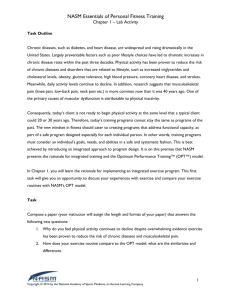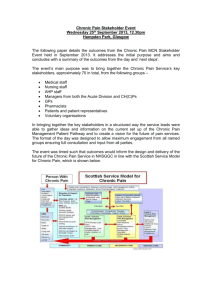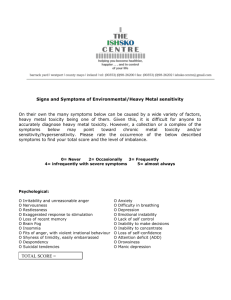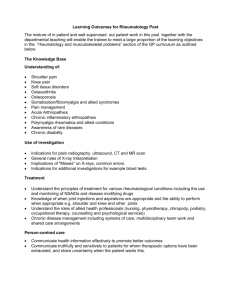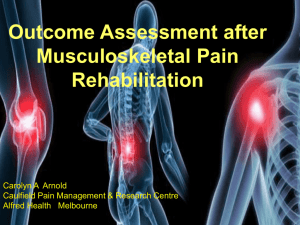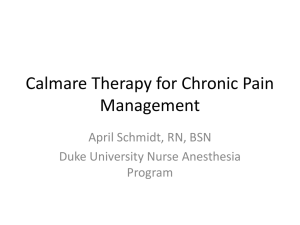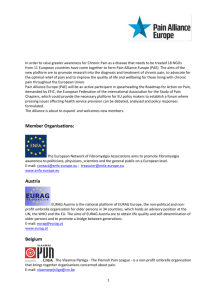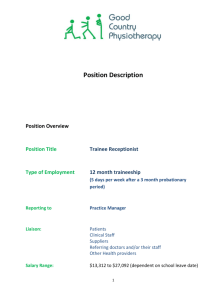Moving with Pain A physiotherapy led pain management programme
advertisement
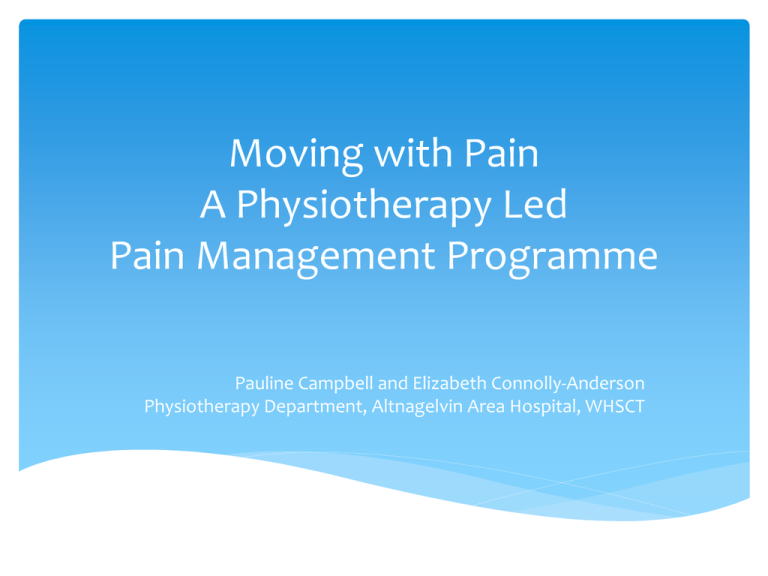
Moving with Pain A Physiotherapy Led Pain Management Programme Pauline Campbell and Elizabeth Connolly-Anderson Physiotherapy Department, Altnagelvin Area Hospital, WHSCT Overview Chronic Pain Incidence NI Context Previous Service Provision The Way Forward “Moving with Pain” Programme Outcome Measures Quantitative and Qualitative results The Future Chronic Pain Incidence (Breivik et al, 2006) Uk Average; 1 in 7 (7.8 million people) Regional Figures: North East/Yorkshire North West East Midlands West Midlands East London South East South West Wales Scotland Northern Ireland 9.0% 16.5% 9.3% 17.5% 12.9% 14.3% 13.2% 13.4% 9.9% 18.1% 19.0% NI Context 2005 – Raft of recommendations for how pain services could be improved 2010 – ‘little progression for these recommendations’ (apart from CREST guidelines, 2008) www.arthritiscare.org.uk/.../PainProposalUKSnapshotFinal.pdf 19.4% of people in NI aged 16-64 have experienced sexual violence or abuse (French & Freel, 2009) Ilex Briefing (2009), Derry-Londonderry - ‘large proportions of children living in poverty, low employment rates, large numbers of families reliant on benefits, premature mortality and poor educational outcomes WHSCT MSK “Core” Physiotherapy- 90% Chronic MSK Pain Referrals WHSCT: Previous Physiotherapy Provision Biomedical Ax 1:1 Treatment Functional Rehab Class Little use of Outcome measures Perceived high re-referral rates High Dropout rates Reported Barriers to participation The Way Forward Patient Feedback Self Management Evidenced Based Practice Group Staff Education PATIENT Outcome measures Biopsychosocial Assessment Evidence Review Clinical Guidelines in Chronic Pain Management were reviewed – European Chronic Low Back Pain (2004), NICE Persistent Low Back Pain (2009) Systematic reviews of the evidence for chronic musculoskeletal pain management were conducted A multimodal programme was devised Evidence based components: Education Relaxation Training Goal Setting Exercise Outcomes Measures Outcome measures were chosen in accordance with the IMMPACT recommendations of core outcome measures in chronic pain clinical trials (Dworkin et al, 2005) BPI, PSEQ, PGIC A qualitative study was conducted to capture service users’ lived experience with chronic pain Re-referral rates to the physiotherapy were also examined ‘Moving With Pain’ Patient Feedback Venn Diagram summarises qualitative analysis of 111 feedback forms Quantitative Results Clinical Outcome Measure Pre BPI – ‘worst pain’ 7.2 (4.03) 6.77 (4.02) p 0.02 PSEQ - mean 2.5 (1.61) 2.87 (1.62) p <0.001 PGIC N/A 3.61 (1.61) N/A Re-Referral Rate Post Statistical Significance Pre Post Statistical Significance 0.08 (27.11) 0.01 (13.86) p <0.001 NI Healthcare Awards 2014 Pain Management Programme of the Year Judges’ Comments The ‘Moving With Pain’ programme was unanimously selected by the judges from a very strong field. It is commended for an innovative approach to overcoming the fear of moving with pain in those with musculoskeletal pain. Their robust outcome measures showed considerable movement over a traditional functional rehabilitation programme and patient satisfaction was high. Referral to the physiotherapy department was reduced by 87%, a significant reduction in cost and resource. The Future… Moving with Pain available Trust Wide Staff Development - Economies of time, lack of staff skills or other resources risk reducing the effectiveness of the programme to a point where gains are insignificant. http://www.britishpainsociety.org/book_pmp2013_main.pdf Group for < 18yr olds Patient Involvement-focus Group and 1 year follow-up Application for funding for Tea/coffee and Primary Care/Community Setting
